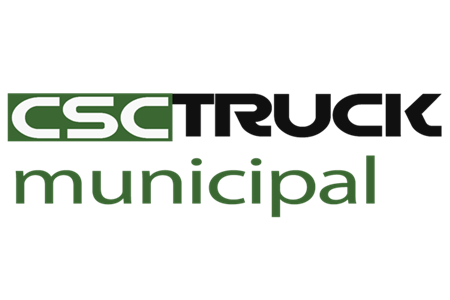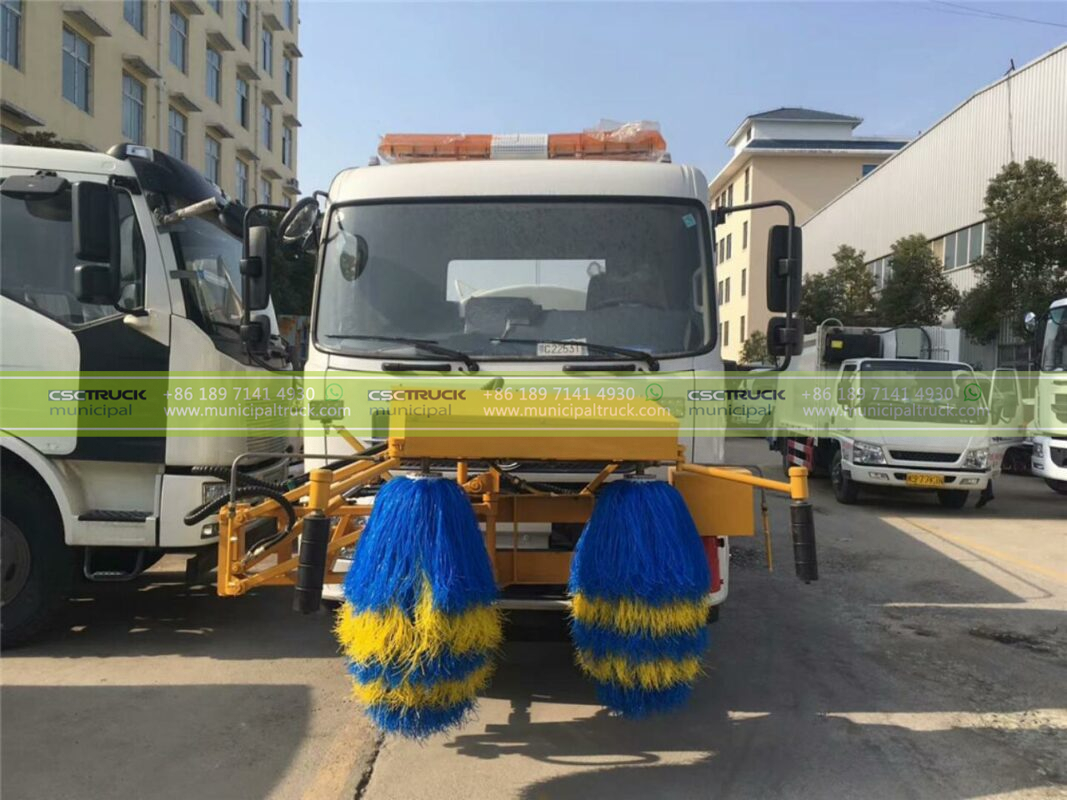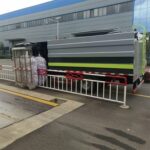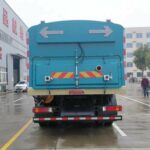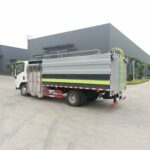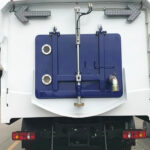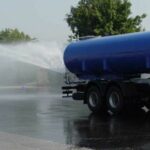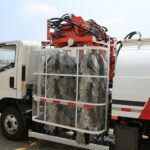In the intricate choreography of facility management, agricultural operations, and municipal infrastructure upkeep, the perimeter often stands as the critical first line of defense against a multitude of encroaching threats – invasive weeds, combustible debris, unsightly litter, and pervasive contaminants that undermine safety, aesthetics, and operational integrity. While traditional landscaping and cleaning methods struggle with the scale, complexity, and often hazardous nature of perimeter zones, a specialized class of equipment has emerged as the definitive solution: the fence sweeper truck. These highly engineered vehicles represent far more than mere convenience; they embody a strategic approach to securing perimeter hygiene through systematic, mechanized intervention. By seamlessly integrating robust sweeping, precise spraying, and debris management capabilities, fence sweeper trucks proactively transform vulnerable boundaries into resilient, well-maintained barriers, mitigating risks before they escalate into costly problems and ensuring that the crucial edges of our managed spaces remain clean, compliant, and secure.
Engineering for the Edge: The Anatomy of a Fence Sweeper Truck
Unlike conventional road sweeper trucks designed for open pavement, the fence sweeper truck is a purpose-built machine, meticulously engineered to navigate the unique challenges presented by linear barriers. Its design prioritizes maneuverability, targeted application, and resilience against the demanding environments it operates within:
- Specialized Chassis & Maneuverability: Built on agile, often compact chassis (frequently utilizing articulated steering or multi-axle configurations), these trucks excel in navigating tight spaces, uneven terrain, and close proximity to fences without causing damage. Enhanced ground clearance and robust suspension systems allow them to traverse ditches, embankments, and rough access roads common along perimeter lines. Low-speed control systems ensure precise movement critical for effective cleaning adjacent to structures.
- Advanced Sweeping & Brushing Technology: The core function resides in sophisticated sweeping mechanisms:
- Angled Main Brush Systems: Powerful, laterally adjustable main brushes, often featuring stiff-bristle configurations for heavy debris or flexible polymer filaments for delicate surfaces, sweep debris directly from the fence line and immediate vicinity towards the center of the truck’s path. Variable speed control allows operators to adjust aggression based on debris type.
- Side or Contour Brushes: Smaller, vertically mounted brushes positioned close to the fence line perform the critical task of dislodging material trapped directly against fence posts, mesh, or rails. These brushes conform to minor irregularities in the fence structure, ensuring comprehensive cleaning.
- High-Vacuum Debris Recovery: Integrated high-capacity vacuum systems, powered by dedicated engines, efficiently collect the dislodged debris – from leaves and litter to heavier organic matter and even fine dust – channeling it into large-volume hoppers. Advanced filtration systems minimize dust emissions during operation, crucial for air quality control near sensitive sites.
- Integrated Spray Systems for Comprehensive Hygiene: Beyond dry sweeping, modern fence sweeper trucks incorporate sophisticated liquid application systems:
- Targeted Spray Bars: Precisely positioned spray nozzles along the brushing assembly or on dedicated booms deliver water, herbicides, algaecides, or disinfectants directly onto the fence structure and the ground immediately beside it. This suppresses dust during dry sweeping, controls weed growth at the base, and aids in cleaning off organic residues or bird droppings.
- High-Pressure Wash Capability: Many units feature optional or integrated high-pressure washing wands or jets, allowing operators to tackle stubborn grime, grease, or biological buildup directly on fence surfaces for a deeper clean.
- Liquid Tankage & Metering: Dedicated tanks hold water and chemical solutions, featuring proportioning systems for accurate chemical application and flow control valves to minimize waste and ensure environmental compliance.
Operational Imperatives: Key Applications Driving Adoption
The versatility of the fence sweeper truck makes it indispensable across diverse sectors where perimeter integrity is non-negotiable:
- Industrial & Commercial Facility Management: Maintaining a clean, debris-free perimeter is paramount for security, fire prevention, and corporate image. Fence sweeper trucks efficiently clear flammable materials (dry grass, leaves, litter) creating vital firebreaks, remove litter that attracts pests, and manage vegetation that could obscure security cameras or provide cover for intruders. They are essential around manufacturing plants, logistics hubs, data centers, and large campuses.
- Agricultural Security & Biosecurity: In modern agriculture, perimeters are critical biosecurity barriers. Fence sweeper trucks play a vital role in:
- Weed Control: Preventing invasive weeds from encroaching onto fields or establishing along fence lines, reducing competition for crops and eliminating habitats for pests and rodents.
- Debris Removal: Clearing wind-blown plant material and fallen branches that can harbor diseases or pests near sensitive livestock areas or greenhouses.
- Access Road Maintenance: Keeping access roads alongside perimeter fences clear, ensuring year-round accessibility for security patrols and emergency services.
- Municipal & Utility Infrastructure: Managing extensive linear infrastructure like reservoirs, power substations, water treatment plants, and transportation corridors requires efficient perimeter maintenance. Fence sweeper trucks prevent vegetation overgrowth that could interfere with operations, reduce fire risk near critical infrastructure, and maintain clear sightlines for security personnel. They efficiently manage debris along miles of fencing, a task impractical with manual labor.
- Waste Management & Landfill Operations: Landfills require stringent perimeter control to prevent wind-blown litter escaping the site. Fence sweeper trucks are deployed to constantly clean fence lines, capturing escaped debris and suppressing dust, crucial for environmental compliance and community relations.
Environmental & Operational Advantages: Beyond Basic Cleaning
The adoption of fence sweeper trucks delivers significant benefits that extend far beyond visible cleanliness:
- Enhanced Safety & Risk Mitigation: Proactively removing combustible debris creates defensible space, significantly reducing the risk of perimeter fires igniting and spreading towards structures or sensitive areas. Eliminating trip hazards and controlling poisonous plants (like ivy) improves safety for personnel working near fences. Dust suppression capabilities directly improve air quality for workers and nearby communities.
- Superior Efficiency & Cost Reduction: Mechanized cleaning along miles of fencing is exponentially faster and requires far less labor than manual methods. The ability to sweep and apply treatments (weed control, dust suppression) in a single pass maximizes operational efficiency, reducing fuel consumption, labor hours, and overall operational costs. Consistent maintenance prevents minor issues from escalating into costly repairs (e.g., vegetation damaging fences, major weed infestations).
- Environmental Stewardship & Compliance: Precise application systems minimize chemical runoff by targeting only the necessary areas, reducing environmental impact. Efficient debris collection prevents litter and potentially harmful materials from migrating into surrounding ecosystems. Consistent perimeter hygiene helps facilities meet stringent environmental regulations and corporate sustainability goals related to waste management, pollution prevention, and land stewardship.
- Improved Asset Longevity & Aesthetics: Regular removal of debris, moisture, and corrosive materials (like road salt near fences) significantly extends the lifespan of perimeter fencing and associated structures. Maintaining a clean, well-kept perimeter projects professionalism, enhances property values, and fosters positive community relations for businesses and municipalities alike.
The Future of Perimeter Management: Integration and Intelligence
The evolution of fence sweeper technology is rapidly advancing, driven by demands for greater precision, efficiency, and data integration:
- Telematics & Fleet Management: Sophisticated GPS tracking and performance monitoring systems provide real-time data on route coverage, chemical usage, fuel consumption, and machine health. This enables optimized scheduling, predictive maintenance, and verifiable reporting for compliance and auditing purposes.
- Automation & Guidance Systems: Advancements in machine vision and semi-autonomous navigation are beginning to emerge. Systems capable of detecting fence lines and maintaining optimal cleaning distance automatically reduce operator fatigue and improve consistency, especially on long, straight runs. Obstacle detection sensors enhance safety in complex environments.
- Precision Application Evolution: Integration with GIS mapping allows for highly targeted application of herbicides or other treatments only where specific weed species are known to exist, minimizing chemical use. Variable-rate spraying technology adjusts flow based on vehicle speed and pre-programmed zones.
- Synergy with Complementary Fleets: The fence sweeper truck is increasingly recognized as a vital component within a comprehensive municipal or facility management fleet. Its role in maintaining critical linear barriers complements the broader area coverage of traditional road sweeper trucks that keep main thoroughfares clear. Furthermore, its targeted spraying capabilities work in concert with larger sprinkler trucks used for broader dust control on access roads or site stabilization projects; while the sprinkler truck addresses large-scale airborne dust or surface wetting needs, the fence sweeper provides the surgical precision required right at the vulnerable interface of the perimeter, ensuring no zone is neglected. This integrated fleet approach ensures seamless coverage – from the heart of a facility’s operations, out along its access roads, and right up to its defining edge – creating a holistic strategy for hygiene, safety, and environmental control that safeguards assets and communities from the perimeter inward. This layered defense is the future of proactive infrastructure stewardship.
